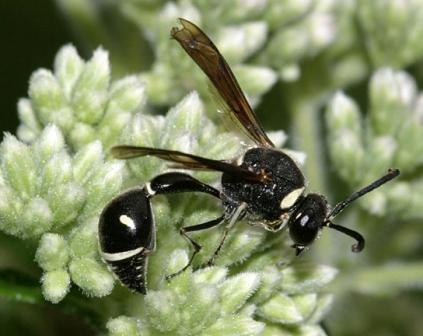At first, I wasn’t sure what they were: Four tiny round structures firmly attached to
a thin willow twig in shallow water.
.JPG) |
| Four marble-size structures attached to a thin willow twig in the shallow lake water |
Nests, I presumed, belonging to some sort of insect. The dwellings – if that’s what they were – appeared
to be made of mud, bleached white and dried by the sun. Adding to their mystery and allure, each marble-shaped
building had a single entry hole. I was immediately
intrigued. Although I saw no insect
entering or leaving, my gut said the nests belonged to some sort of wasp.
Curious, I began researching as soon as I returned home. What I discovered reinforced my instinct – a
wasp did indeed make the nests. More
importantly, the information I uncovered introduced me to a world of wonder and
fascinating facts about one of nature’s often unnoticed but important creatures.
The tiny structures I observed were built by Eumenes
fraternus, commonly known as ‘potter wasp’ or ‘mason wasp’ because its small round
nest looks so much like a miniature hand-thrown clay pot. A potter wasp is just under an inch long,
predominantly black with thin ivory bands along its thorax and abdomen and a
noticeably elongated, narrow waist.
 |
| Potter wasps have very narrow waists and distinctive colors that make them easy to identify. Photo credit: www.organicgardeninfo.com |
Unlike social wasps that live in groups, potter wasps are
solitary insects. Adults feed on flower
nectar and are not aggressive toward people.
They rarely sting, even when inadvertently touched and are considered beneficial
because they control caterpillars that harm garden plants.
I found little of note about the male wasp since his role centers
on the act of procreation alone. However,
the female, who is larger than her male counterpart, has multiple jobs. After mating, she must find a nest site, gather
materials needed for the laborious job of building a structure and then procure
enough food to secure her future offspring’s survival. Only then does she deposit eggs – one egg per
domed cell – before sealing it within the cell with more mud over the entry
hole. When all these tasks are complete,
she flies off to begin the process again in the next structure.
Although the initial nests I found were on a willow twig growing
in the lake’s shallow water, I’ve since discovered other potter wasp nests on
window screens, attached to shrubbery and irrigation pipes.
 |
| Potter wasp building nest on our irrigation pipe |
Apparently, the main factor the female wasp
seeks in a location is to be somewhat close to a source of mud, since mud is
the main component of the soon-to-be-built nest.
A potter wasp nest is an architectural marvel. The
female wasp begins by finding a wet patch of sandy soil. Using her mandibles, she rolls a portion of the
muddy soil into a ball, which she carries back to deposit on the nest site, spread
out and mix with saliva to increase its hardness. This tedious procedure involves repeated mud-gathering
trips until an adobe-like round brood cell takes shape. When the structure is an appropriate size (big
enough to accommodate one egg and enough food to sustain its growth) the female
flies off to stock the larder with caterpillars.
This is when things get interesting.
When the wasp finds a caterpillar, she stings it just enough
venom to cause paralysis but not death. She
then lugs the inert bug back to the cell to stuff inside the small round opening
she left in the jug-like structure. After
much effort, the hole is filled with anywhere from one to twelve caterpillars.
The sex of the future wasp depends upon the number of the caterpillars upon which it will feast. In nests containing more than five caterpillars, a female wasp will emerge. If the nest contains fewer caterpillars, the wasp will be male.
The sex of the future wasp depends upon the number of the caterpillars upon which it will feast. In nests containing more than five caterpillars, a female wasp will emerge. If the nest contains fewer caterpillars, the wasp will be male.
Once she has secured an adequate food supply, the female
lays a single egg suspended above the caterpillar mass by a strong thread,
backs out of the hole and covers the opening with more balls of mud moistened
and smoothed out with saliva. At this
point, her responsibilities to that particular egg are over and she is ready to
repeat the procedure for her next future offspring.
Meanwhile, inside its mud incubator, the developing wasp
larva feeds on the fresh meat of the unfortunate caterpillars until the food is
gone and the wasp is ready to leave the nest.
At that point, the emerging potter wasp drills though the side of its
adobe abode to begin the cycle anew.
I had no idea my discovery of four white, round domed shells
attached to a willow twig would trigger such a wealth of new information.
Every time I observe some previously
unfamiliar object like the potter wasp, I can’t help but wonder how many other
unknown marvels I miss even though they are right there in plain sight.
The discovery of the potter wasp nest was my latest reminder
that nature has so much to offer if I only take the time to look.
A "Simply" Extra
I found a fascinating 8-minute video online documenting how a potter wasp builds its nest, stuffs numerous caterpillars into it and then seals it up tight. You can watch it by clicking on the following link: Potter Wasp or Mason Wasp - Master Architect.

No comments:
Post a Comment